Search Results
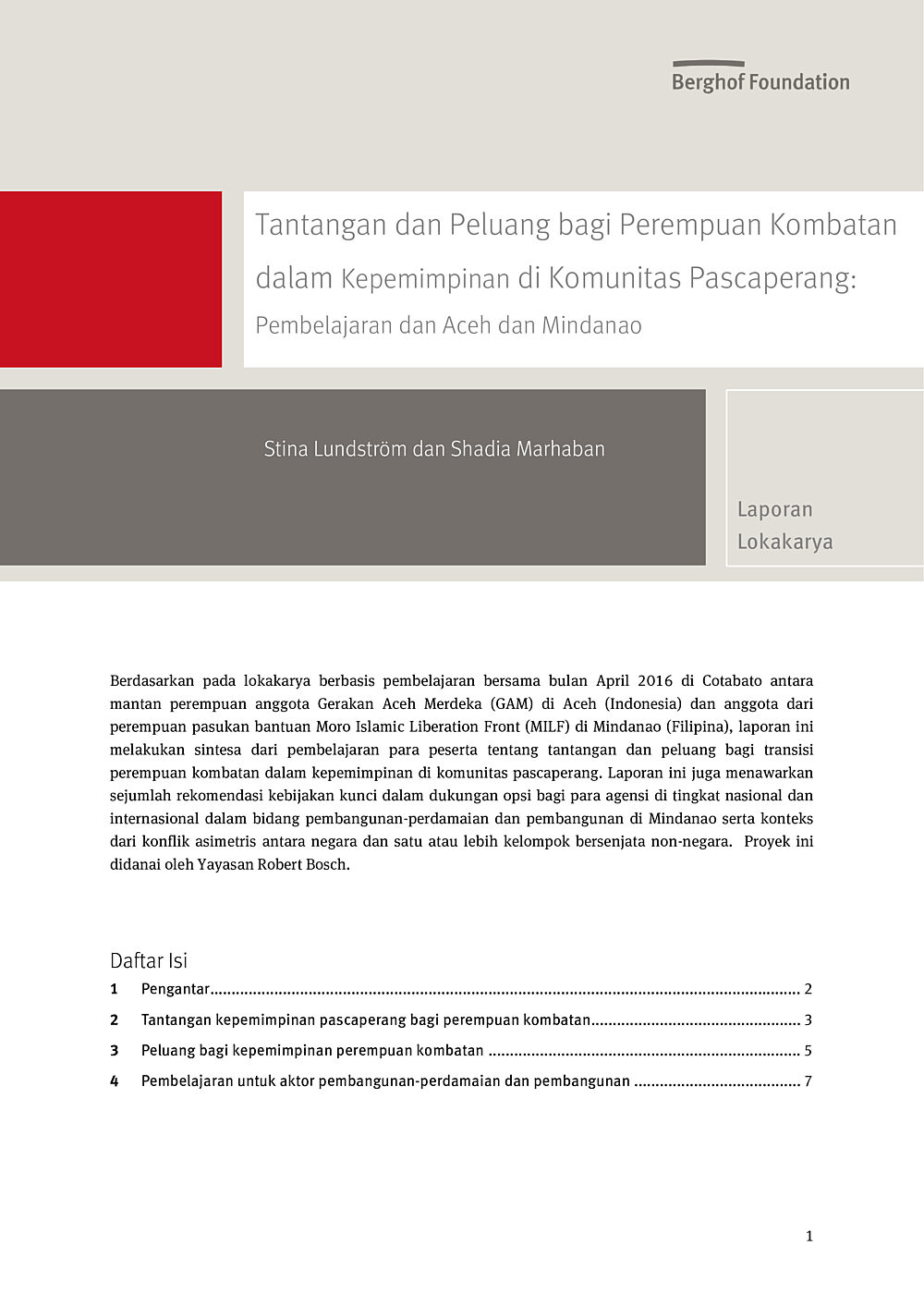
Tantangan dan Peluang bagi Perempuan Kombatan dalam Kepemimpinan di Komunitas PascaperangPembelajaran dan Aceh dan Mindanao (Laporan Lokakarya)
Berdasarkan pada lokakarya berbasis pembelajaran bersama bulan April 2016 di Cotabato antara mantan perempuan anggota Gerakan Aceh Merdeka (GAM) di Aceh (Indonesia) dan anggota dari perempuan pasukan bantuan Moro Islamic Liberation Front (MILF) di Mindanao (Filipina), laporan ini melakukan sintesa dari pembelajaran para peserta tentang tantangan dan peluang bagi transisi perempuan kombatan dalam kepemimpinan di komunitas pascaperang. Laporan ini juga menawarkan sejumlah rekomendasi kebijakan kunci dalam dukungan opsi bagi para agensi di tingkat nasional dan internasional dalam bidang pembangunan-perdamaian dan pembangunan di Mindanao serta konteks dari konflik asimetris antara negara dan satu atau lebih kelompok bersenjata non-negara.
- Year 2016
- Author(s) Stina Lundström, Shadia Marhaban
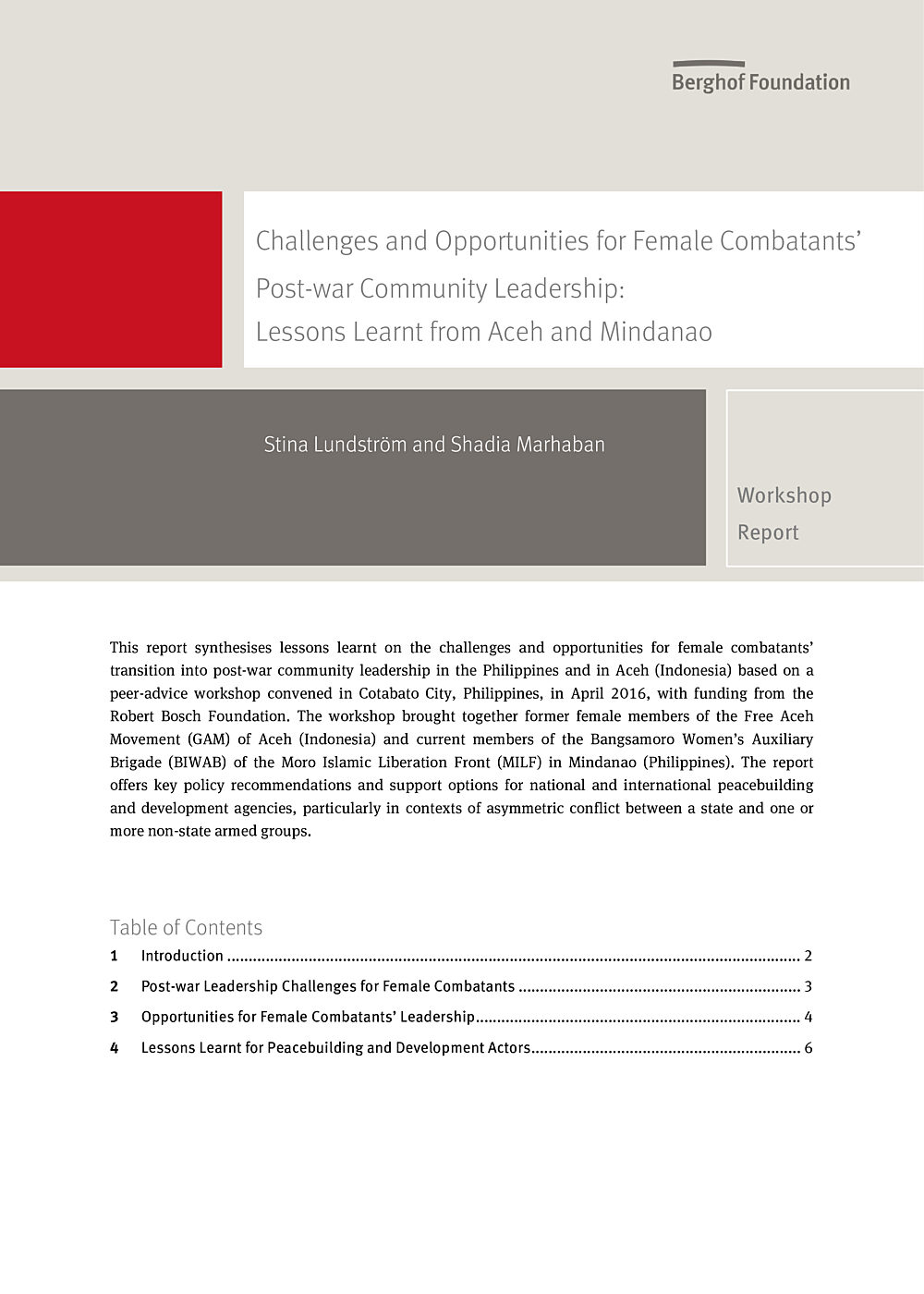
Challenges and Opportunities for Female Combatants’ Post-War Community LeadershipLessons Learnt from Aceh and Mindanao (Workshop Report)
This report synthesises lessons learnt on the challenges and opportunities for female combatants’ transition into post-war community leadership in the Philippines and in Aceh (Indonesia) based on a peer-advice workshop convened in Cotabato City, Philippines, in April 2016, with funding from the Robert Bosch Foundation. The workshop brought together former female members of the Free Aceh Movement (GAM) of Aceh (Indonesia) and current members of the Bangsamoro Women’s Auxiliary Brigade (BIWAB) of the Moro Islamic Liberation Front (MILF) in Mindanao (Philippines). The report offers key policy recommendations and support options for national and international peacebuilding and development agencies, particularly in contexts of asymmetric conflict between a state and one or more non-state armed groups.
- Year 2016
- Author(s) Stina Lundström, Shadia Marhaban

Tradition- & Faith-Oriented Insider Mediators (TFIMs) as Crucial Actors in Conflict TransformationPotential, Constraints, & Opportunities for Collaborative Support (Baseline Study)
This study on tradition- and faith- oriented insider mediators (TFIMs) has been produced using both existing knowledge on insider mediators and tradition- and faith-oriented local peacebuilding, and original data acquired through field studies.
- Year 2016
- Author(s) Mir Mubashir, Luxshi Vimalarajah
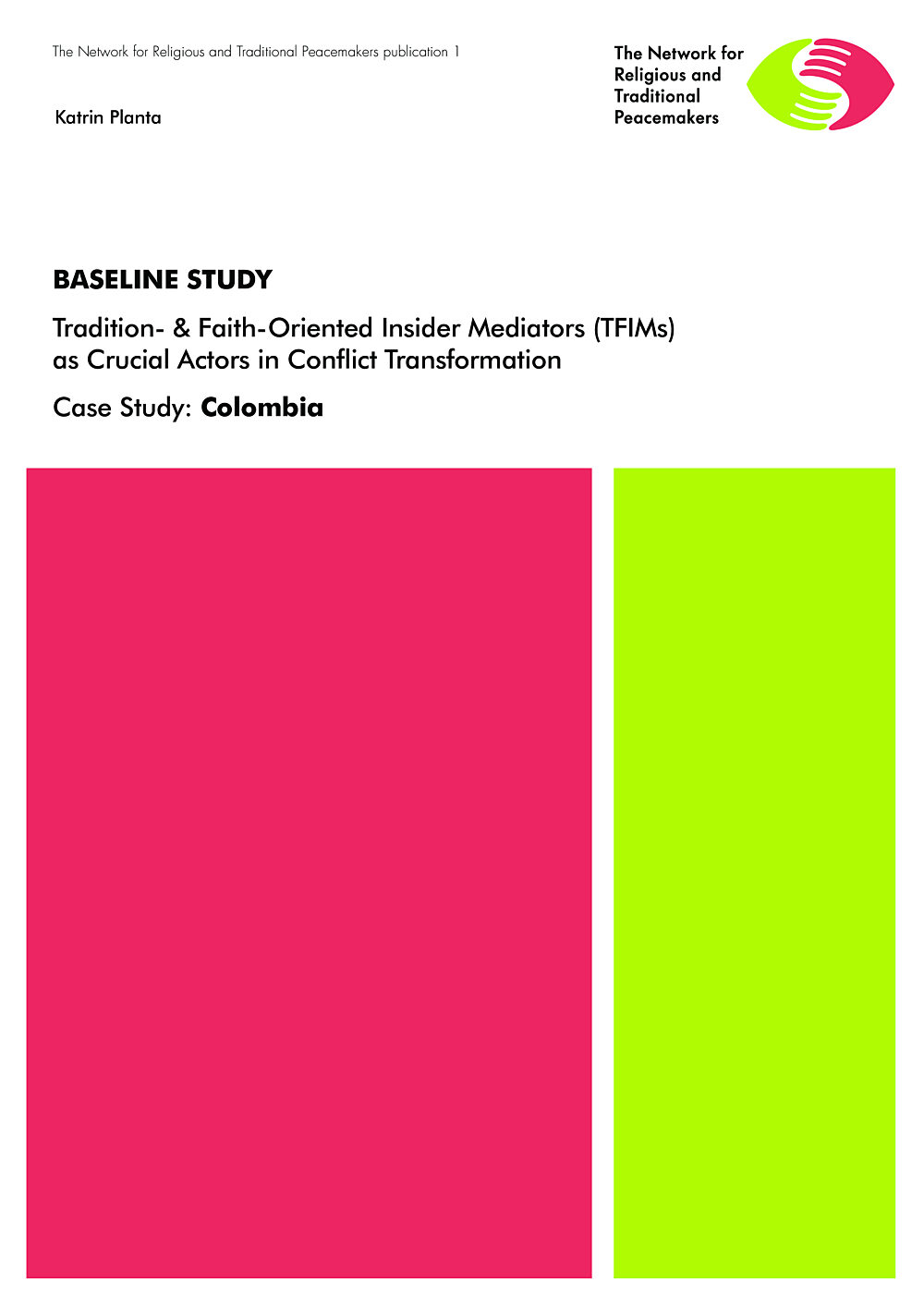
Tradition- & Faith-Oriented Insider Mediators (TFIMs) as Crucial Actors in Conflict TransformationCase Study: Colombia
This case study on tradition- and faith- oriented insider mediators (TFIMs) in Colombia has been produced using both existing knowledge on insider mediators and tradition- and faith-oriented local peacebuilding, and original data acquired through field studies.
- Year 2016
- Author(s) Katrin Planta

Tradition- & Faith-Oriented Insider Mediators (TFIMs) as Crucial Actors in Conflict TransformationCase Study: Southern Thailand
This case study on tradition- and faith- oriented insider mediators (TFIMs) in Southern Thailand has been produced using both existing knowledge on insider mediators and tradition- and faith-oriented local peacebuilding, and original data acquired through field studies.
- Year 2016
- Author(s) Jularat Damrongviteetham
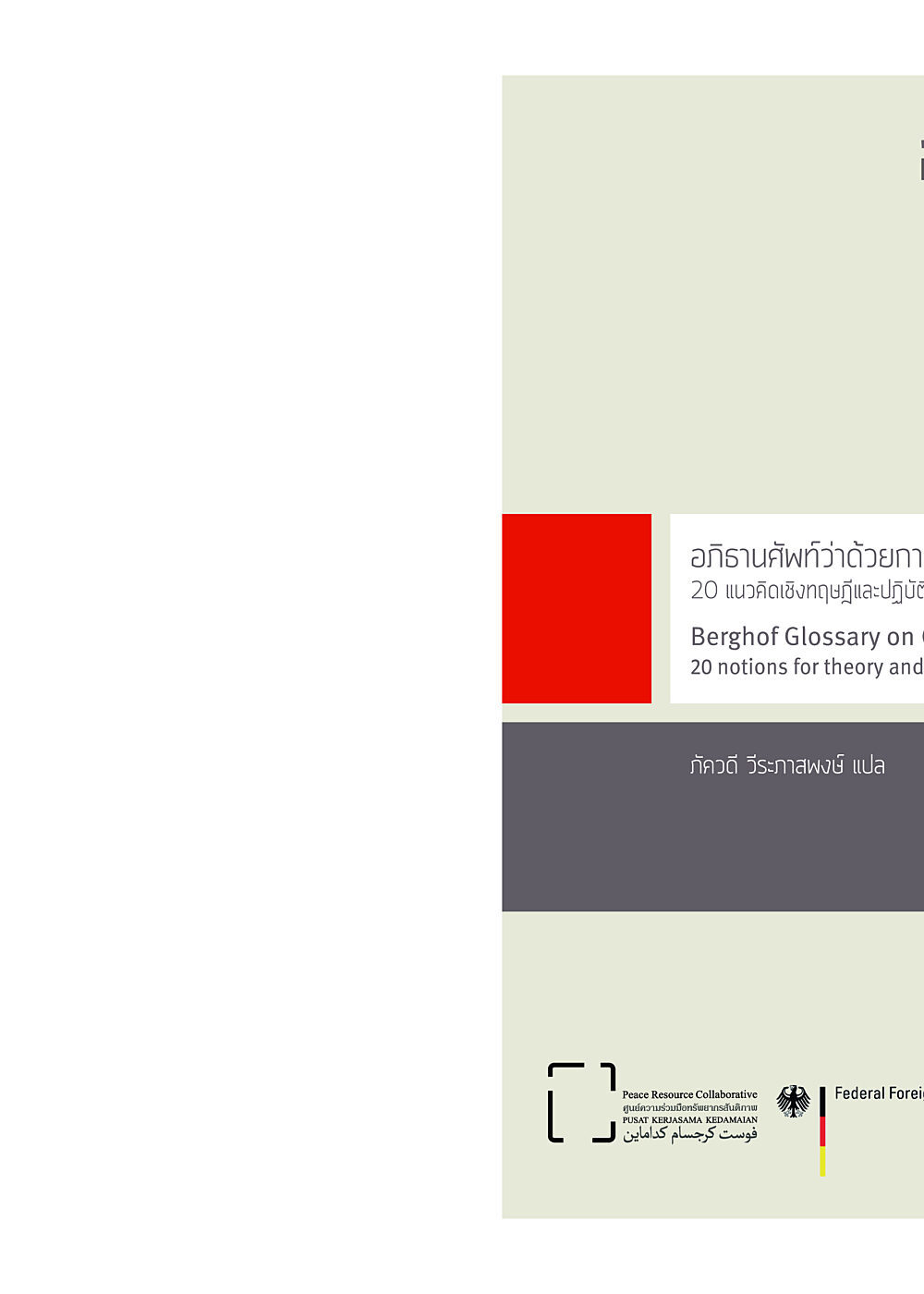
อภิธานศัพท์ว่าด้วยการแปรเปลี่ยนความขัดแย้ง20 แนวคิดเชิงทฤษฎีและปฏิบัติ
หนังสืออภิธานศัพท์เล่มนี้นิยามและอภิปรายถึงค�ำศัพท์ส�ำคัญ 20 ค�ำ ที่เกี่ยวข้องกับการแปรเปลี่ยนความขัดแย้งในการท�ำงานของมูลนิธิ Berghof ท�ำไมจึงต้องจัดท�ำอภิธานศัพท์อีกเล่มและท�ำไมต้องจ�ำเพาะ เจาะจงเป็นอภิธานศัพท์ว่าด้วยการแปรเปลี่ยนความขัดแย้งด้วย? ประการแรก กรอบความคิดเกี่ยวกับ “การแปรเปลี่ยนความขัดแย้ง” เป็นแนวทางที่ค่อนข้างใหม่และมีความแตกต่างชัดเจนในวาทกรรม ระดับโลกเกี่ยวกับความขัดแย้งและกระบวนการสร้างสันติภาพ การ แปรเปลี่ยนความขัดแย้งมีทัศนะว่าการด�ำรงอยู่ของความขัดแย้งเป็น ส่วนที่มีคุณค่าและขาดไม่ได้ในการเปลี่ยนแปลงและการพัฒนาสังคม แต่ไม่ได้มองว่าความรุนแรงเป็นสิ่งที่หลีกเลี่ยงไม่ได้ในความสัมพันธ์ และปฏิสัมพันธ์ระหว่างฝ่ายขัดแย้ง ด้วยเหตุนี้เอง แนวทางนี้จึงไม่ได้ มองว่า “การคลี่คลาย” ความขัดแย้งเป็นเป้าหมายส�ำคัญที่สุดหรือ สูงสุดของภารกิจ ตรงกันข้าม แนวทางนี้มีเป้าหมายที่จะวางรากฐาน ความสัมพันธ์เชิงสร้างสรรค์ระหว่างตัวแสดงที่ขัดแย้งกัน และช่วยวาง โครงสร้างที่จ�ำเป็นส�ำหรับสันติภาพที่ยืนยาว วิธีการที่ใช้คือการโน้มน�ำ สาเหตุที่เป็นรากเหง้าของความขัดแย้งไปในทิศทางที่ยุทธศาสตร์ การไม่ใช้ความรุนแรงสามารถจัดการปัญหาได้ส�ำเร็จอย่างยั่งยืน
- Year 2016
- Author(s) Berghof Foundation
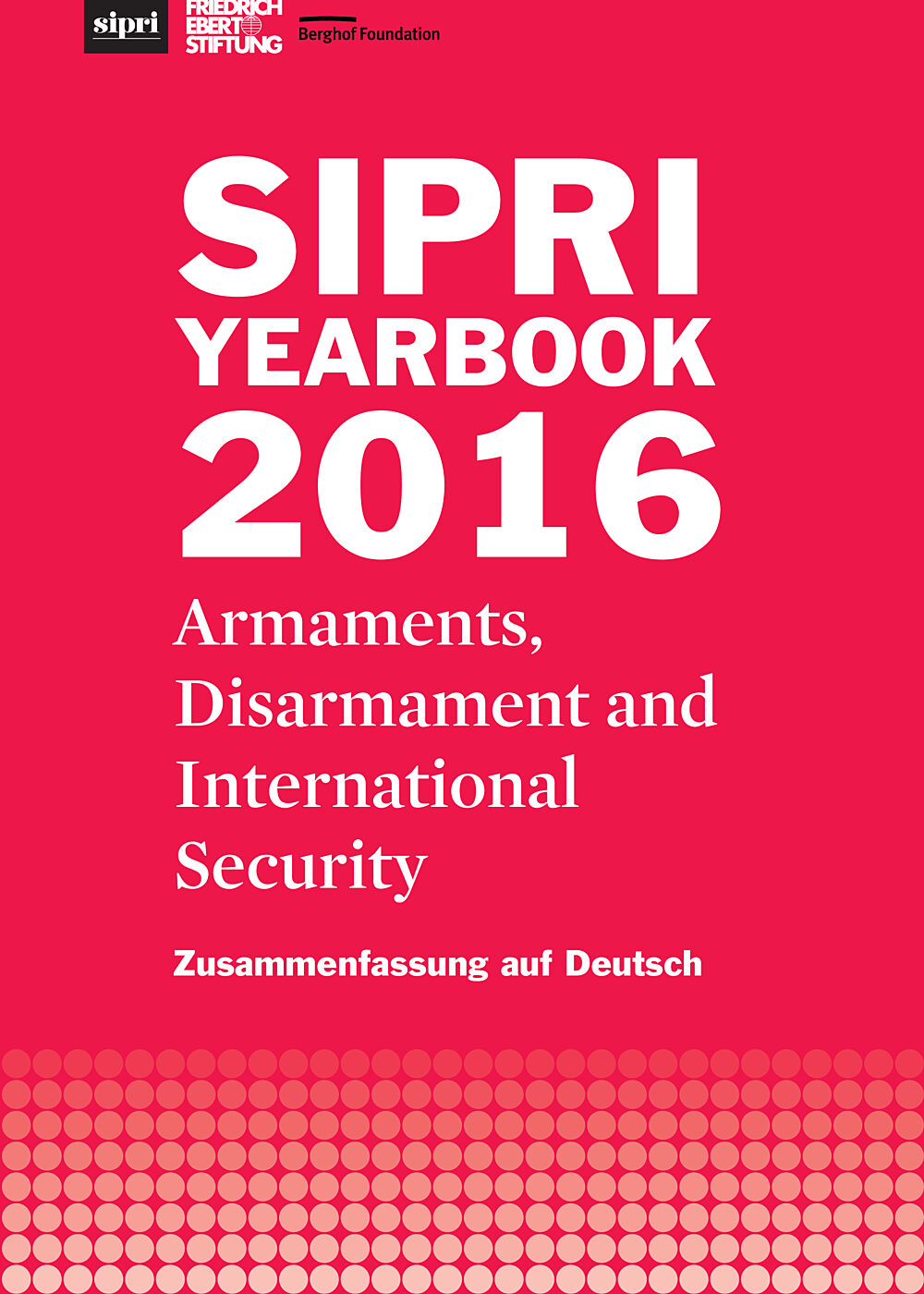
SIPRI Yearbook 2016Armaments, Disarmaments and Internatinal Security (Kurzfassung Deutsch)
Das SIPRI Yearbook 2016 stellt Originaldaten aus den Bereichen globale Militärausgaben, internationale Rüstungstransfers, Rüstungsproduktion, Atomstreitkräfte, bewaffnete Konflikte und multilaterale Friedenseinsätze zusammen und liefert neueste Analysen zu wichtigen Aspekten der Rüstungskontrolle, des Friedens und der internationalen Sicherheit. Das SIPRI-Jahrbuch ist erstmals 1969 erschienen. Es wird gemeinsam von Forschern von SIPRI und eingeladenen, externen Fachleuten verfasst. Diese Broschüre fasst die Inhalte des SIPRI Yearbook 2016 zusammen und enthält eine Auswahl an Daten und Informationen daraus.
- Year 2016
- Author(s) Stockholm International Peace Research Institute (SIPRI), Friedrich Ebert Stiftung, Berghof Foundation
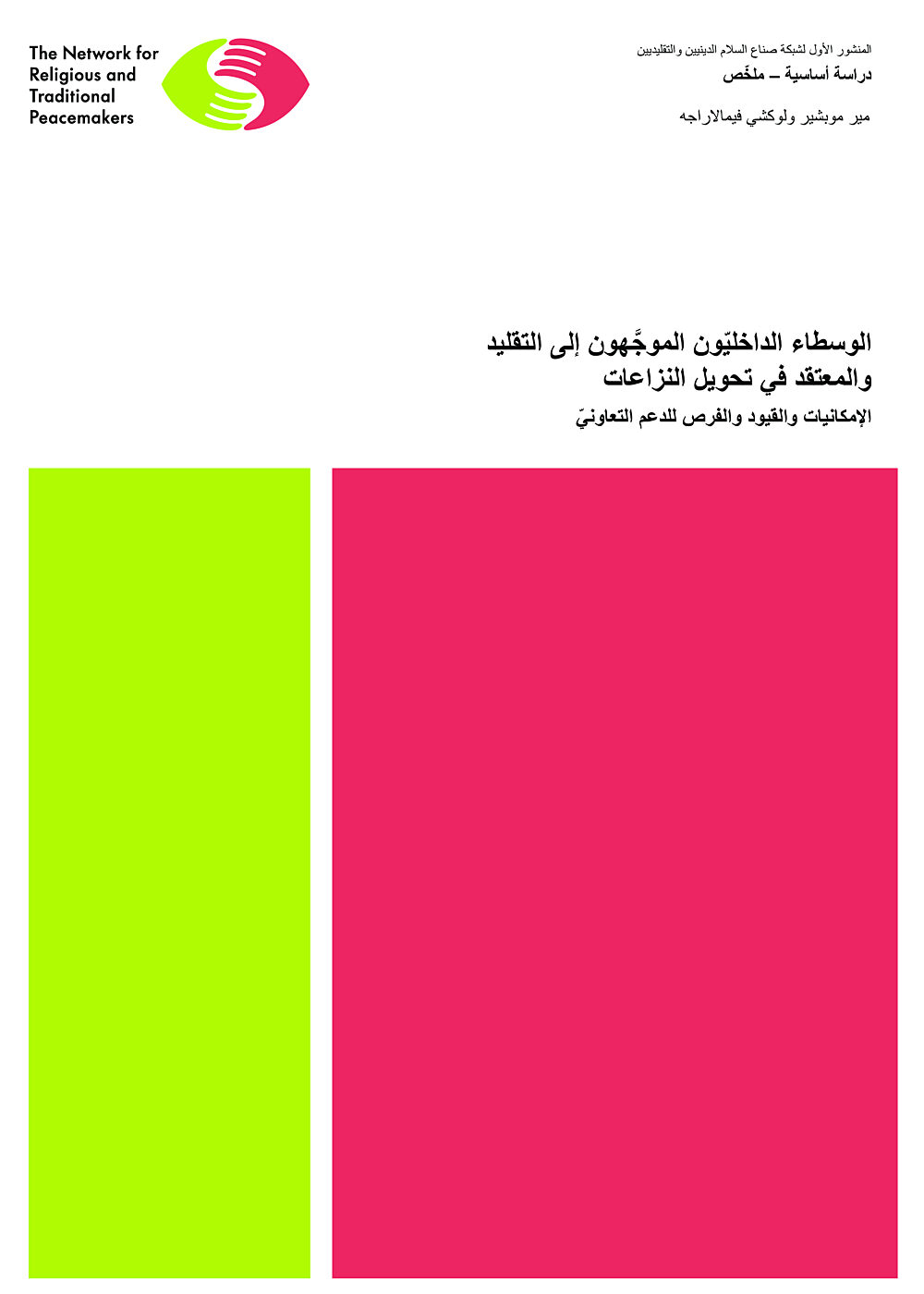
الوسطاء الداخلي َّ ون الموجهون إلى التقليد والمعتقد في تحويل النزاعاتاإلمكانيات والقيود والفرص للدعم التعاوني
[ترجمة آلية الملخص]
تم إعداد هذه الدراسة حول الوسطاء الداخليين ذوي التوجهات الدينية والتقاليد (TFIMs) باستخدام المعرفة الموجودة حول الوسطاء المطلعين وبناء السلام المحلي الموجه نحو التقاليد والعقيدة ، والبيانات الأصلية التي تم الحصول عليها من خلال الدراسات الميدانية.
- Year 2016
- Author(s) Mir Mubashir, Luxshi Vimalarajah

Organisations under pressure but powering on: The psychosocial approach within integrated management of threatA model for human rights organisations and donor organisations
This guide offers a model and elaborates its recommendations for threatened human rights organisations and donor organisations on dealing with threat in an integrated manner. It specifically focuses on incorporating a psychosocial approach into the organisations’ routines, spaces and structures as a crucial element of integrated threat management. Drawing together lessons and insights from a joint learning process within the framework of the project “MAPA”, it emphasises how HRO and donors can work together towards achieving this goal. The guide is meant to help initiate a change process and stimulate further engagement with the topic, thereby seeking to contribute to maintaining human rights organisations’ scope for action in violent contexts. Understood as complementary to existing literature, this interactive guide provides links to other publications on the topic.
- Year 2016
- Author(s) Antonia Montanus, Nele Rathke, Barbara Unger
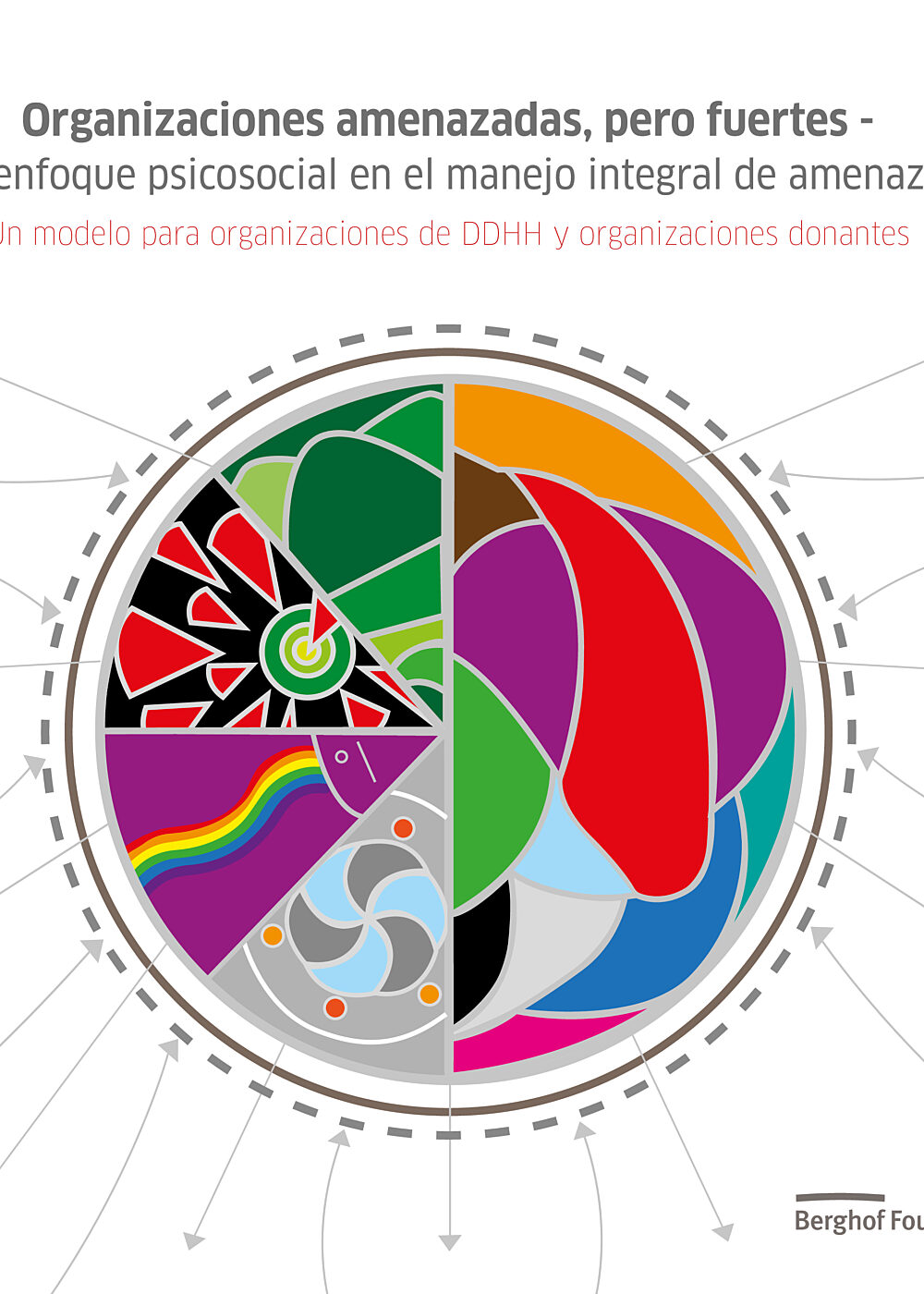
Organizaciones amenazadas, pero fuertes - Un enfoque psicosocial en el manejo integral de amenazasUn modelo para organizaciones de DDHH y organizaciones donantes
Este guía brinda un modelo y detalla recomendaciones para organizaciones de DDHH amenazadas y organizaciones donantes sobre cómo integrar un enfoque psicosocial en las rutinas, espacios y estructuras de sus organizaciones como elemento clave para un manejo intregal de amenazas. Basado en lecciones de un proceso de aprendizaje conjunto dentro del marco del proyecto MAPA hace hincapié en cómo organizaciones DDHH y donantes pueden conjuntamente trabajar hacía esa meta. El guía apoya a iniciar un proceso de cambio y estimula tratar el tema, contribuyendo así a mantener el espacio de actuación para organizaciones de DDHH en contextos de violencia. Entendido como complementario a recursos existentes, la versión interactiva brinda enlaces a otras publicaciones pertinentes.
- Year 2016
- Author(s) Antonia Montanus, Nele Rathke, Barbara Unger